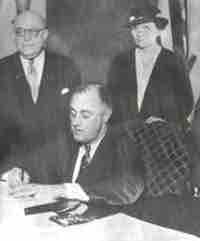LABOR AND THE FIRST NEW DEAL
During the First New Deal (1933-34/5), reforms that aimed to empower labor were limited. One important attempt were labor protection and regulation provisions included in the National Industrial Recovery Act (NIRA, June 1933). Title I of NIRA outlined guidelines for the creation of the so-called "codes of fair competition" (rules according to which industries were supposed to operate), guaranteed trade union rights, and permitted the regulation of working standards (e.g., minimum wages, maximum working hours, etc.). Although business leaders and conservative politicians were critical of the power that NIRA invested in the organized labor and workers generally, NIRA's labor protection provisions turned out to be very difficult to implement. Industry leaders continued to have a large impact on the final shape of the codes and since NIRA lacked guidelines on how to handle negotiations between labor and employers, labor unrest and increased tensions between employers and workers ensued. Although eventually the National Labor Board was established to handle labor-employers conflicts, NIRA failed to secure long-term workers' rights. In 1935, in Schechter Poultry Corp. v. United States, the Supreme Court declared Title I (devoted to industrial recovery) of NIRA unconstitutional. That decision removed whatever limited rights labor had gained through NIRA.
NATIONAL LABOR RELATIONS ACT
In the aftermath of NIRA's failure, the 1935 National Labor Relations Act (NLRA; known also as the Wagner Act) was passed. It offered many of the labor protection and regulation provisions that were earlier included in NIRA. NLRA provided basic rights of private sector employees to organize into trade unions, engage in collective bargaining for better terms and conditions at work, and take collective action, including strike. Unlike NIRA, which tied the same rights to industrial codes, NLRA guaranteed labor rights through the federal government. The act also created the National Labor Relations Board, which was to guarantee the rights included in NLRA (as opposed to merely negotiating labor disputes) and organized labor unions representation elections. NLRA, which remains the landmark legislation of federal labor law, does not apply to workers who are covered by the Railway Labor Act, agricultural laborers, domestic workers (employed in private homes), supervisors, federal, state or local government workers, independent contractors, and workers employed by a parent or spouse. Historically, the exclusion of agricultural and domestic workers from the provisions of NLRA had a disproportionately negative impact on working African Americans, a substantial number of whom fell into one of those two categories.
President Roosevelt signed the legislation into law on July 5, 1935. The concluding paragraph of section 1 states the Act's goal as "to eliminate the causes of certain substantial obstructions to the free flow of commerce and to mitigate and eliminate these obstructions when they have occurred by encouraging the practice and procedure of collective bargaining and by protecting the exercise by workers of full freedom of association, self-organization, and designation of representatives of their own choosing, for the purpose of negotiating the terms and conditions of their employment or other mutual aid or protection."
Under critical section 8(a) , NLRA defines unfair labor practices by employers. These are:
- Interfering with, restraining, or coercing employees in the exercise of their rights under section 7. These rights include freedom of association, mutual aid or protection, self-organization, to form, join, or assist labor organizations, to bargain collectively for wages and working conditions through representatives of their own choosing, and to engage in other protected concerted activities with or without a union. Section 8(a)(1)
- Dominating or interfering with the formation or administration of any labor organization or contributing financial or other support to it. Section 8(a)(2)
- Discriminating against employees to encourage or discourage membership in any labor organization. 8(a)(3)
- Discriminating against employees who file charges or testify under NLRA. 8(a)(4)
- Refusing to bargain collectively with the representatives of the employer's employees. 8(a)(5)
Opponents of NLRA introduced several hundred bills to amend or repeal the law in the decade after its passage. All of them failed or were vetoed until the passage of the 1947 Taft-Hartley Act, which introduced and specified unfair labor practices for labor organizations (additionally to those introduced in 1935 for employers).
FAIR LABOR STANDARD ACT
The 1938 Fair Labor Standards Act (FLSA) is another critical piece of labor legislation passed under the New Deal. To a large extent, FLSA set labor standards that NIRA failed to accomplish. It established a national minimum wage (25 cents per hour in the first year after the Act was passed), overtime standards, and prohibited most employment of minors (individuals under the age 16 or 18, depending on the nature of work) in "oppressive child labor." It also limited the work week to 44 hours (in 1940, amended to 40 hours a week). FLSA did not apply to all industries. Historians estimate that the Act's provisions covered not more than 20% of labor force. Also, the ban on child labor introduced in FLSA did not cover agriculture where child labor was rampant.
FLSA was critical to establishing labor standards that remain the foundation of labor law in the United States. Although the initial draft was more ambitious than the document finally passed by Congress after a long legal battle, federal law that established minimum wages, maximum working hours, and ban on child labor set a standard for how U.S. labor would negotiate future working conditions. Although FLSA was originally applicable to a limited number of workers, it paved the way for later, more inclusive legislation. Over the decades since FLSA was originally signed into law, numerous amendments have been introduced, many of which increased the originally proposed minimum wage.

Roosevelt signs the National Labor Relations Act
Francis Perkins, the Secretary of Labor in the Roosevelt administration, looks on as Franklin Roosevelt signs the National Labor Relations Act.